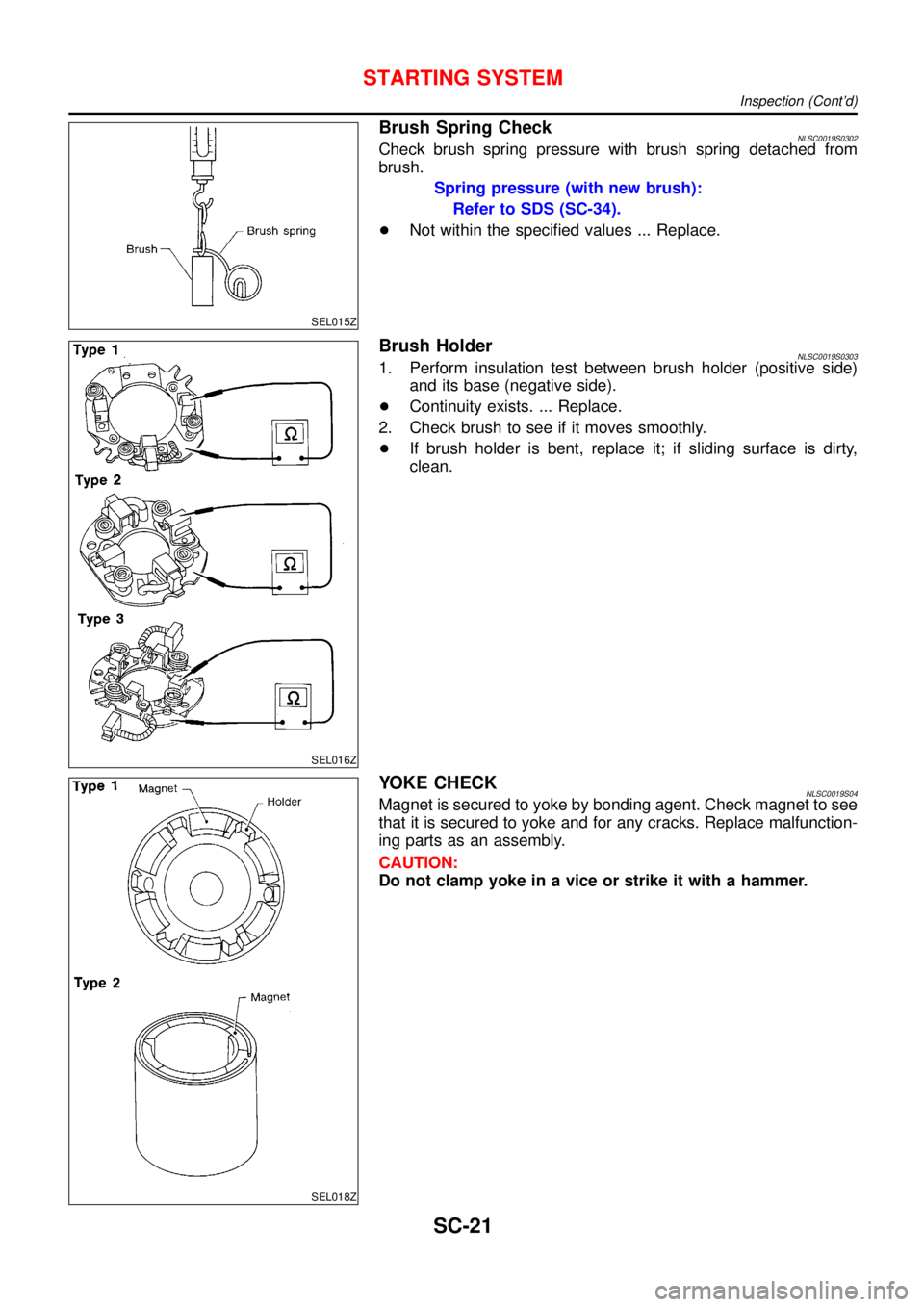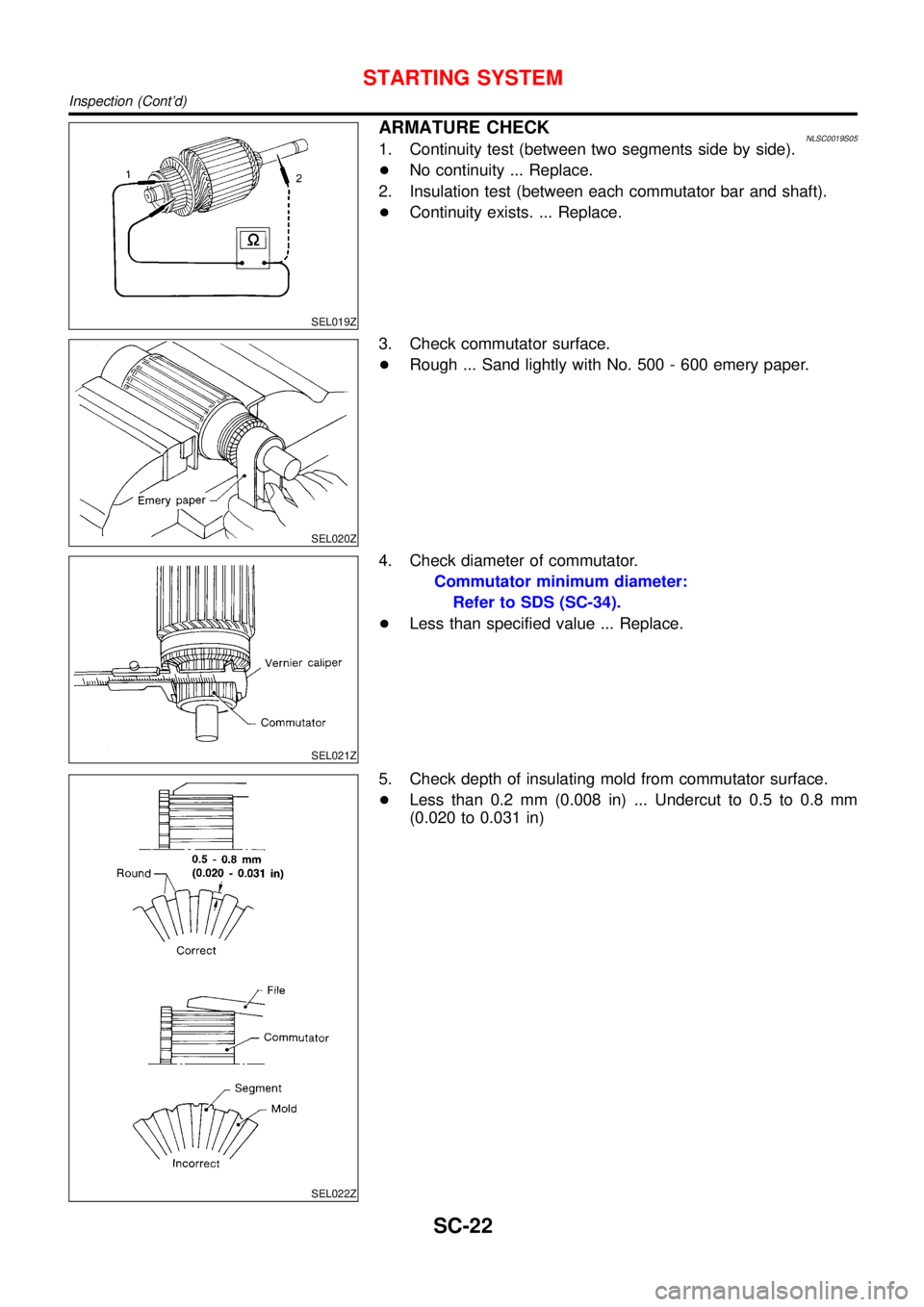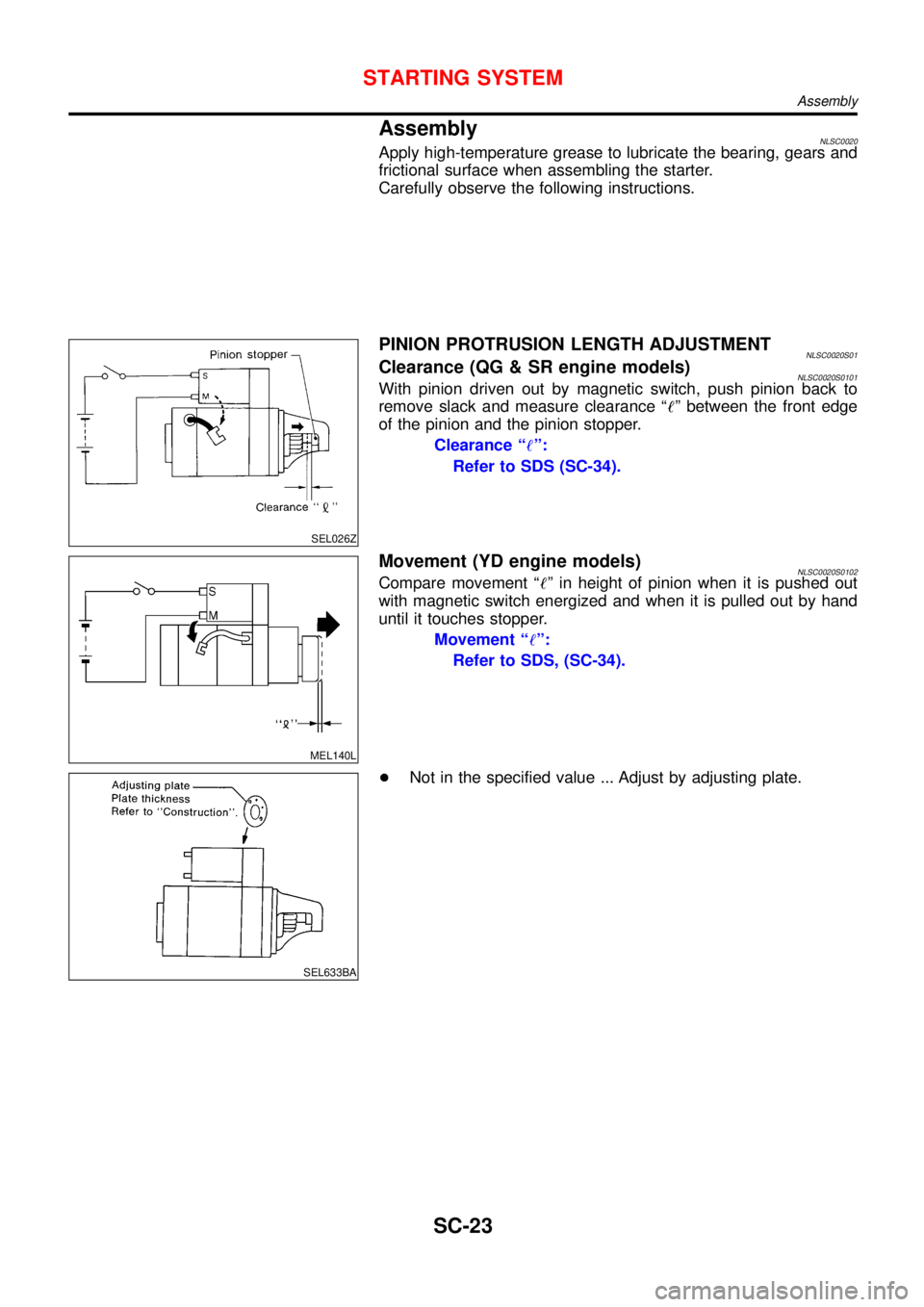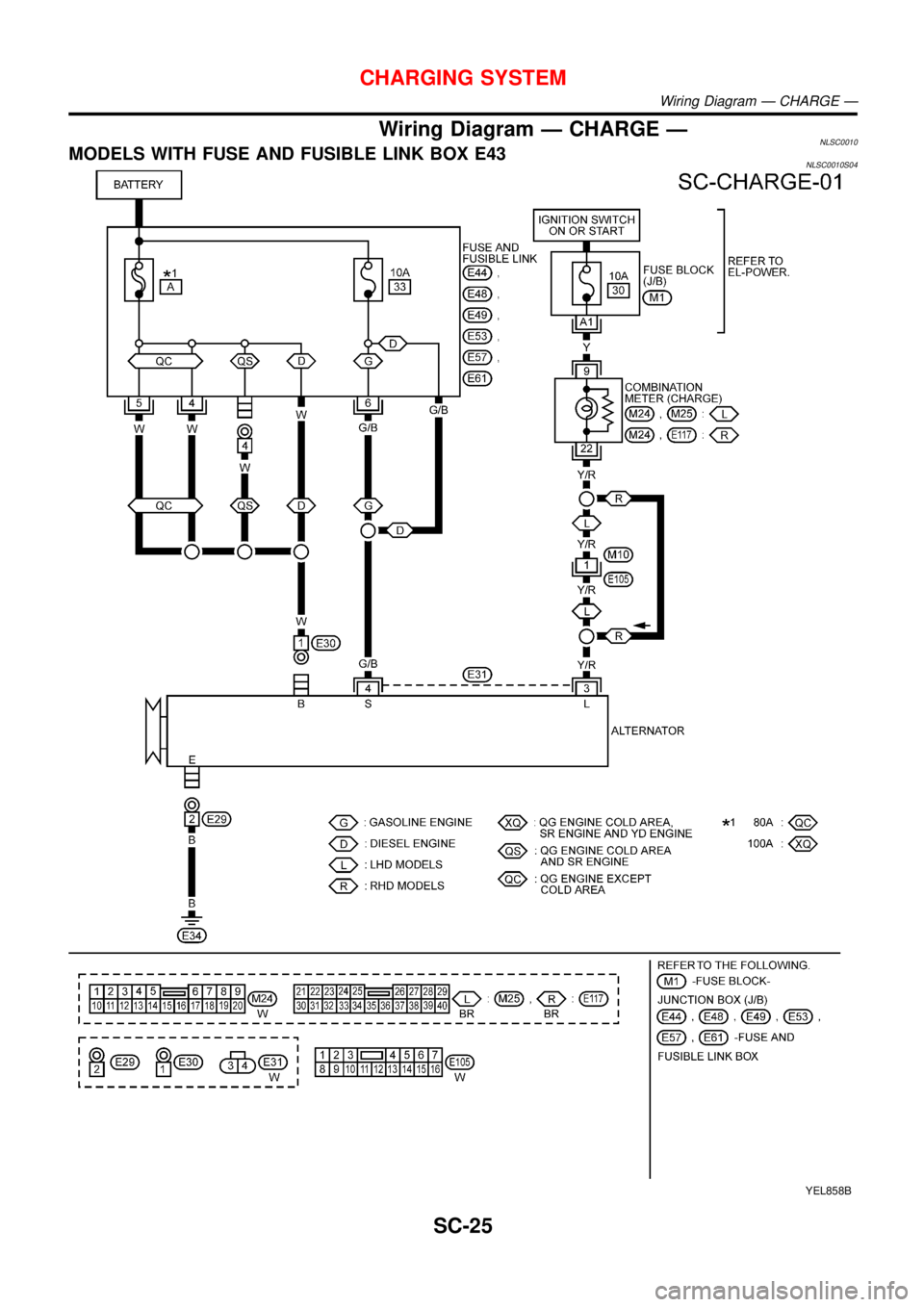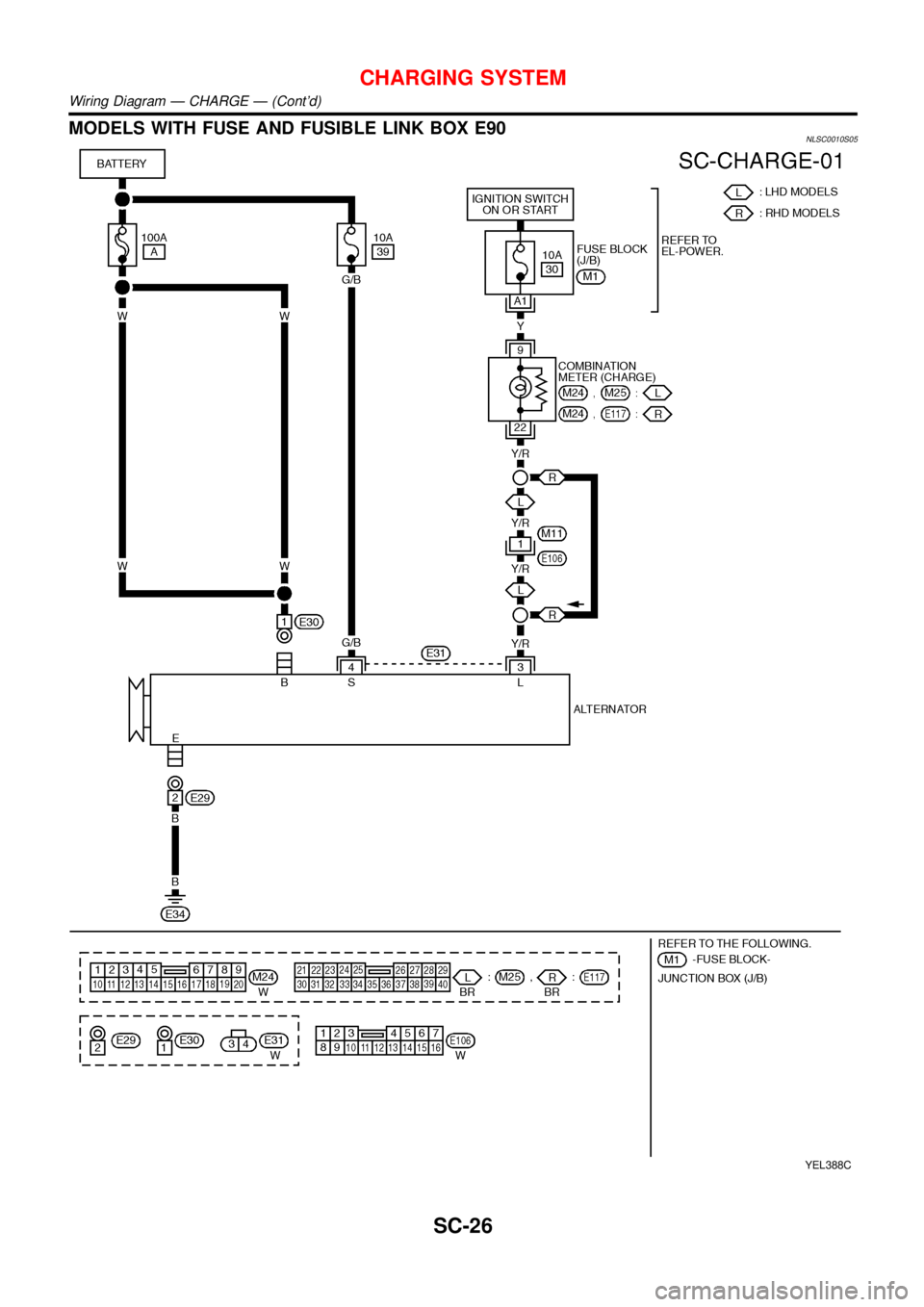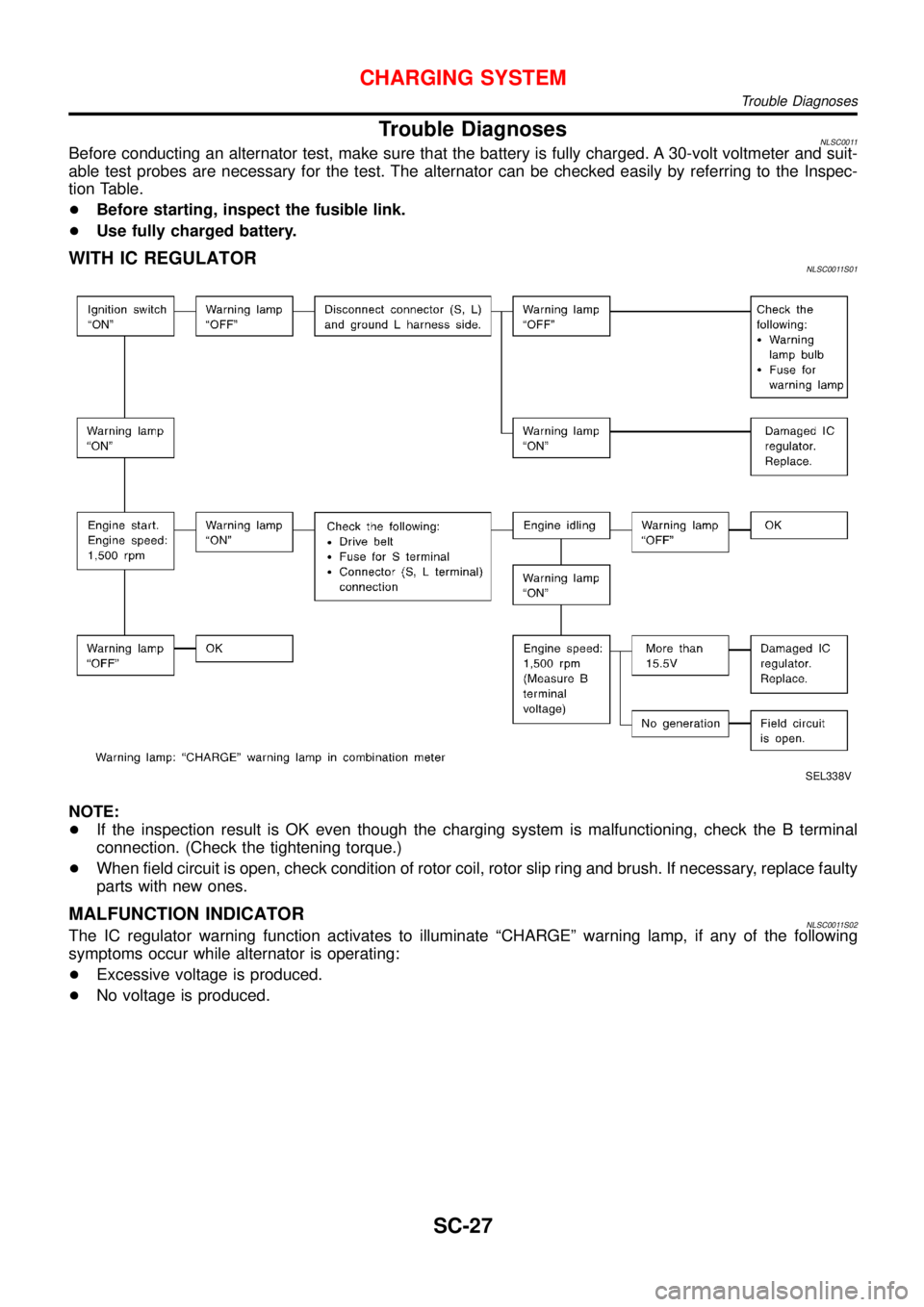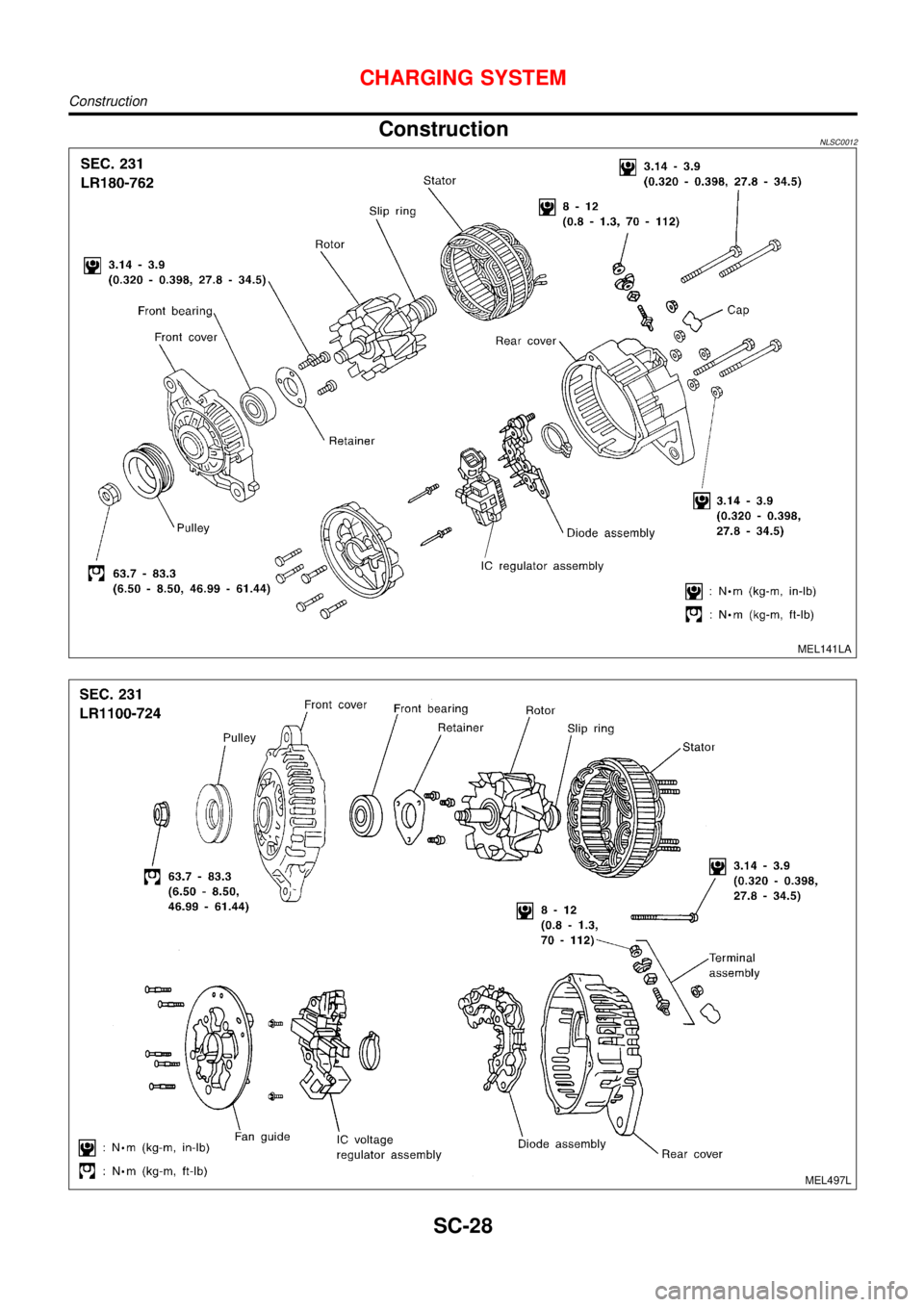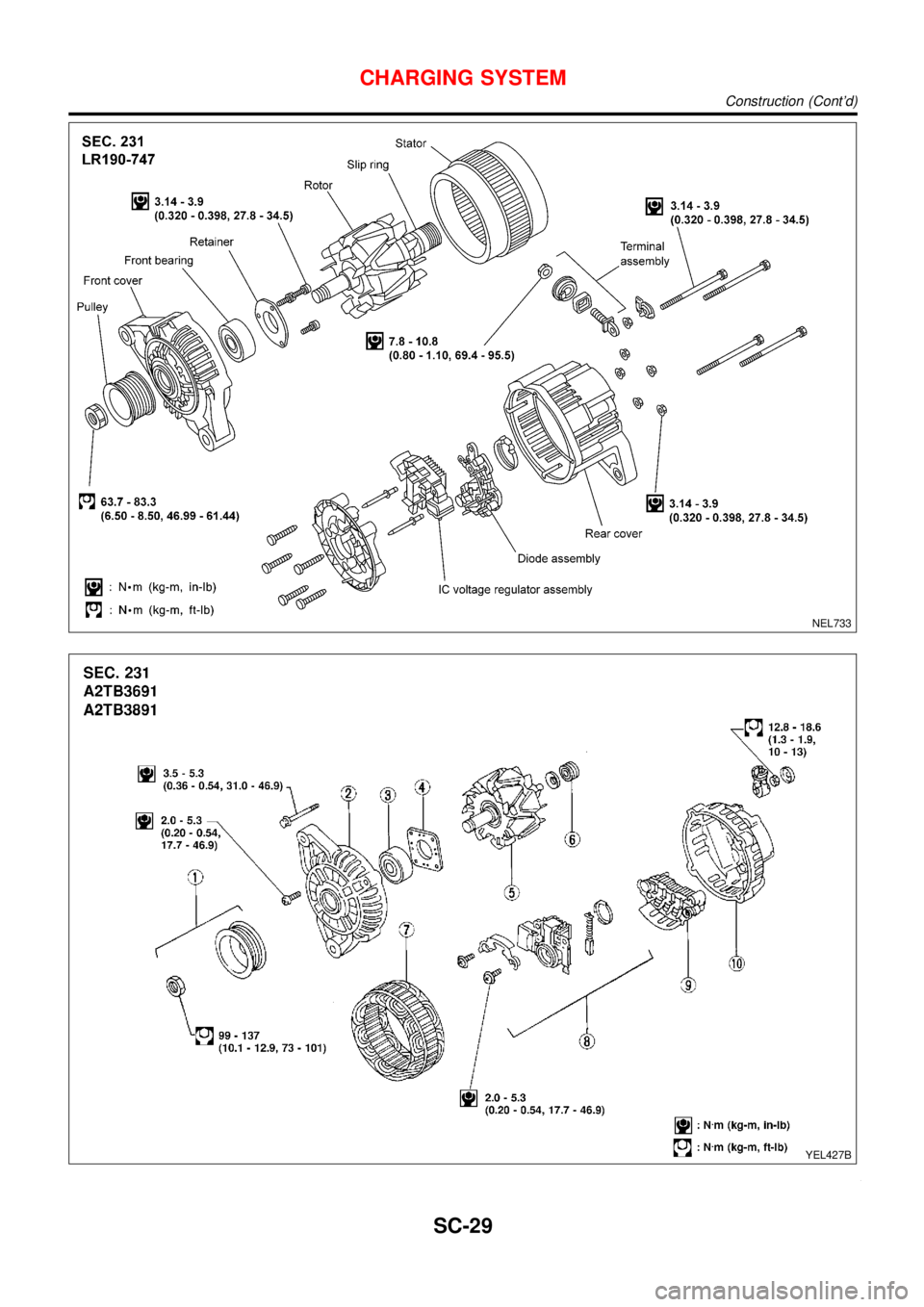NISSAN ALMERA TINO 2001 Service Repair Manual
ALMERA TINO 2001
NISSAN
NISSAN
https://www.carmanualsonline.info/img/5/57352/w960_57352-0.png
NISSAN ALMERA TINO 2001 Service Repair Manual
Trending: exhaust manifold, fuse box diagram, audio, bulb, oil viscosity, gas mileage, service schedule
Page 2981 of 3051
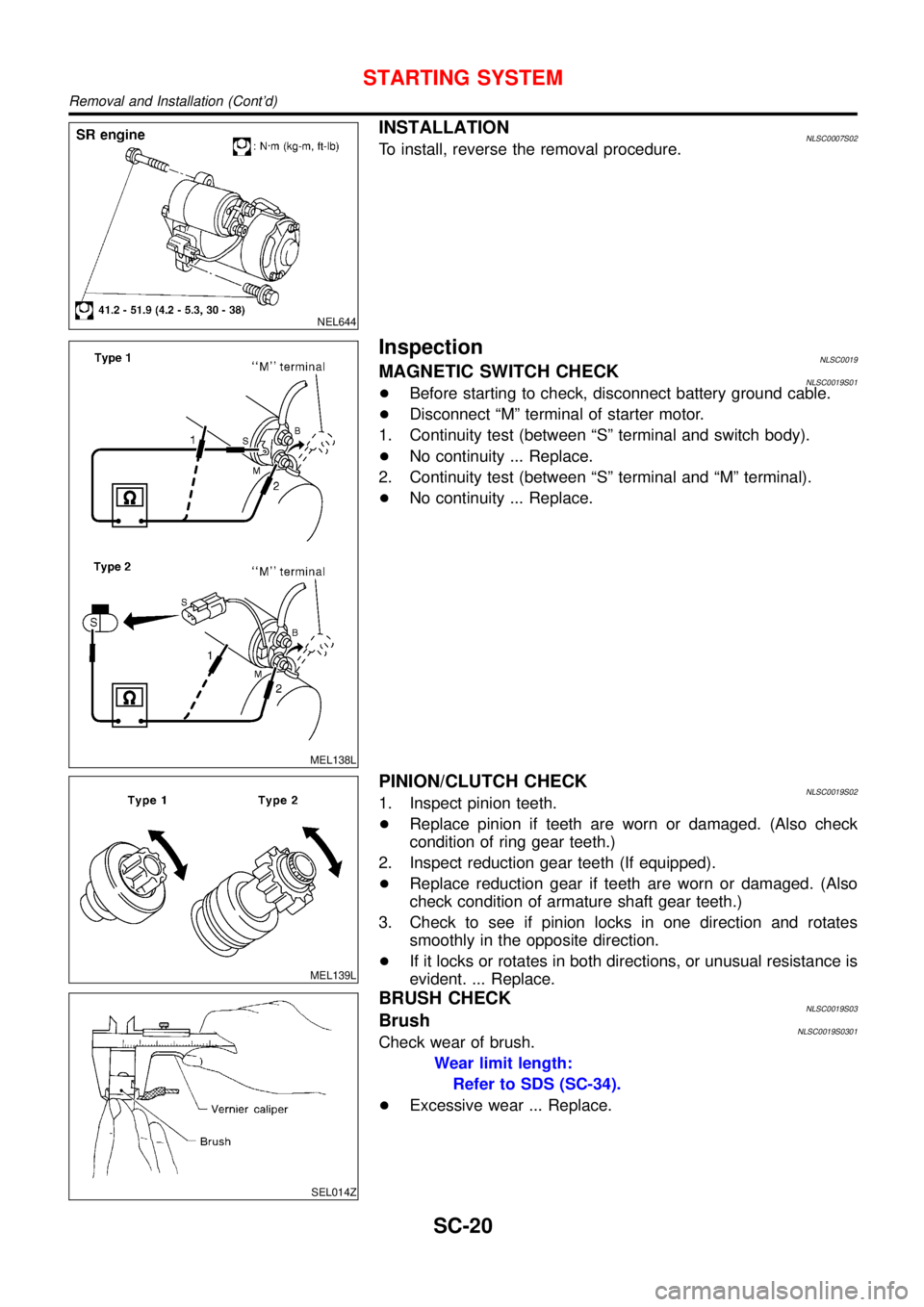
NEL644
INSTALLATIONNLSC0007S02To install, reverse the removal procedure.
MEL138L
InspectionNLSC0019MAGNETIC SWITCH CHECKNLSC0019S01+Before starting to check, disconnect battery ground cable.
+Disconnect“M”terminal of starter motor.
1. Continuity test (between“S”terminal and switch body).
+No continuity ... Replace.
2. Continuity test (between“S”terminal and“M”terminal).
+No continuity ... Replace.
MEL139L
PINION/CLUTCH CHECKNLSC0019S021. Inspect pinion teeth.
+Replace pinion if teeth are worn or damaged. (Also check
condition of ring gear teeth.)
2. Inspect reduction gear teeth (If equipped).
+Replace reduction gear if teeth are worn or damaged. (Also
check condition of armature shaft gear teeth.)
3. Check to see if pinion locks in one direction and rotates
smoothly in the opposite direction.
+If it locks or rotates in both directions, or unusual resistance is
evident. ... Replace.
SEL014Z
BRUSH CHECKNLSC0019S03BrushNLSC0019S0301Check wear of brush.
Wear limit length:
Refer to SDS (SC-34).
+Excessive wear ... Replace.
STARTING SYSTEM
Removal and Installation (Cont’d)
SC-20
Page 2982 of 3051
SEL015Z
Brush Spring CheckNLSC0019S0302Check brush spring pressure with brush spring detached from
brush.
Spring pressure (with new brush):
Refer to SDS (SC-34).
+Not within the specified values ... Replace.
SEL016Z
Brush HolderNLSC0019S03031. Perform insulation test between brush holder (positive side)
and its base (negative side).
+Continuity exists. ... Replace.
2. Check brush to see if it moves smoothly.
+If brush holder is bent, replace it; if sliding surface is dirty,
clean.
SEL018Z
YOKE CHECKNLSC0019S04Magnet is secured to yoke by bonding agent. Check magnet to see
that it is secured to yoke and for any cracks. Replace malfunction-
ing parts as an assembly.
CAUTION:
Do not clamp yoke in a vice or strike it with a hammer.
STARTING SYSTEM
Inspection (Cont’d)
SC-21
Page 2983 of 3051
SEL019Z
ARMATURE CHECKNLSC0019S051. Continuity test (between two segments side by side).
+No continuity ... Replace.
2. Insulation test (between each commutator bar and shaft).
+Continuity exists. ... Replace.
SEL020Z
3. Check commutator surface.
+Rough ... Sand lightly with No. 500 - 600 emery paper.
SEL021Z
4. Check diameter of commutator.
Commutator minimum diameter:
Refer to SDS (SC-34).
+Less than specified value ... Replace.
SEL022Z
5. Check depth of insulating mold from commutator surface.
+Less than 0.2 mm (0.008 in) ... Undercut to 0.5 to 0.8 mm
(0.020 to 0.031 in)
STARTING SYSTEM
Inspection (Cont’d)
SC-22
Page 2984 of 3051
AssemblyNLSC0020Apply high-temperature grease to lubricate the bearing, gears and
frictional surface when assembling the starter.
Carefully observe the following instructions.
SEL026Z
PINION PROTRUSION LENGTH ADJUSTMENTNLSC0020S01Clearance (QG & SR engine models)NLSC0020S0101With pinion driven out by magnetic switch, push pinion back to
remove slack and measure clearance“!”between the front edge
of the pinion and the pinion stopper.
Clearance“!”:
Refer to SDS (SC-34).
MEL140L
Movement (YD engine models)NLSC0020S0102Compare movement“!”in height of pinion when it is pushed out
with magnetic switch energized and when it is pulled out by hand
until it touches stopper.
Movement“!”:
Refer to SDS, (SC-34).
SEL633BA
+Not in the specified value ... Adjust by adjusting plate.
STARTING SYSTEM
Assembly
SC-23
Page 2985 of 3051
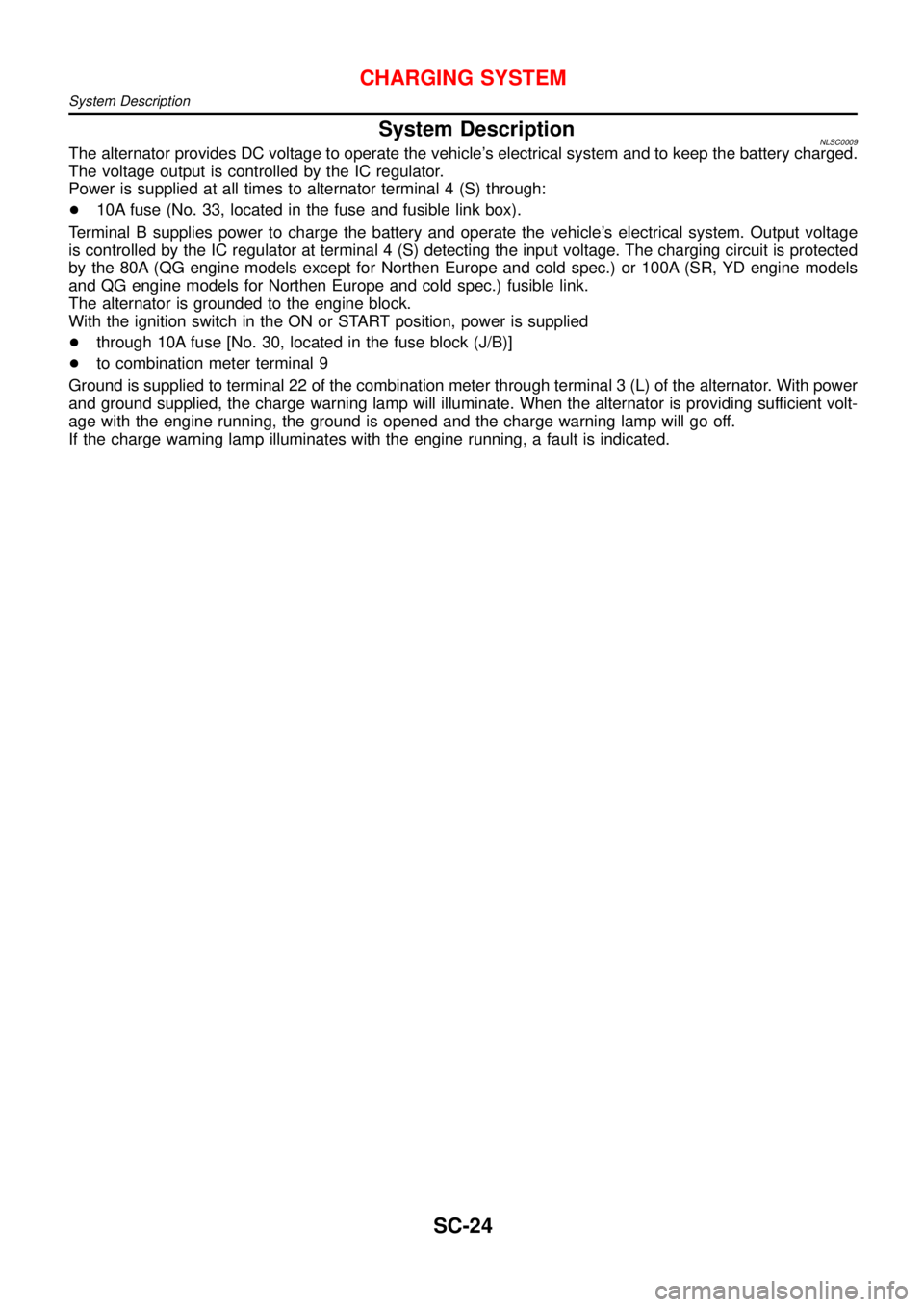
System DescriptionNLSC0009The alternator provides DC voltage to operate the vehicle’s electrical system and to keep the battery charged.
The voltage output is controlled by the IC regulator.
Power is supplied at all times to alternator terminal 4 (S) through:
+10A fuse (No. 33, located in the fuse and fusible link box).
Terminal B supplies power to charge the battery and operate the vehicle’s electrical system. Output voltage
is controlled by the IC regulator at terminal 4 (S) detecting the input voltage. The charging circuit is protected
by the 80A (QG engine models except for Northen Europe and cold spec.) or 100A (SR, YD engine models
and QG engine models for Northen Europe and cold spec.) fusible link.
The alternator is grounded to the engine block.
With the ignition switch in the ON or START position, power is supplied
+through 10A fuse [No. 30, located in the fuse block (J/B)]
+to combination meter terminal 9
Ground is supplied to terminal 22 of the combination meter through terminal 3 (L) of the alternator. With power
and ground supplied, the charge warning lamp will illuminate. When the alternator is providing sufficient volt-
age with the engine running, the ground is opened and the charge warning lamp will go off.
If the charge warning lamp illuminates with the engine running, a fault is indicated.
CHARGING SYSTEM
System Description
SC-24
Page 2986 of 3051
Wiring Diagram—CHARGE—NLSC0010MODELS WITH FUSE AND FUSIBLE LINK BOX E43NLSC0010S04
YEL858B
CHARGING SYSTEM
Wiring Diagram—CHARGE—
SC-25
Page 2987 of 3051
MODELS WITH FUSE AND FUSIBLE LINK BOX E90NLSC0010S05
YEL388C
CHARGING SYSTEM
Wiring Diagram—CHARGE—(Cont’d)
SC-26
Page 2988 of 3051
Trouble DiagnosesNLSC0011Before conducting an alternator test, make sure that the battery is fully charged. A 30-volt voltmeter and suit-
able test probes are necessary for the test. The alternator can be checked easily by referring to the Inspec-
tion Table.
+Before starting, inspect the fusible link.
+Use fully charged battery.
WITH IC REGULATORNLSC0011S01
SEL338V
NOTE:
+If the inspection result is OK even though the charging system is malfunctioning, check the B terminal
connection. (Check the tightening torque.)
+When field circuit is open, check condition of rotor coil, rotor slip ring and brush. If necessary, replace faulty
parts with new ones.
MALFUNCTION INDICATORNLSC0011S02The IC regulator warning function activates to illuminate“CHARGE”warning lamp, if any of the following
symptoms occur while alternator is operating:
+Excessive voltage is produced.
+No voltage is produced.
CHARGING SYSTEM
Trouble Diagnoses
SC-27
Page 2989 of 3051
ConstructionNLSC0012
MEL141LA
MEL497L
CHARGING SYSTEM
Construction
SC-28
Page 2990 of 3051
NEL733
YEL427B
CHARGING SYSTEM
Construction (Cont’d)
SC-29
Trending: high beam, navigation, belt, ESP inoperative, jacking, BT-20, cooling

